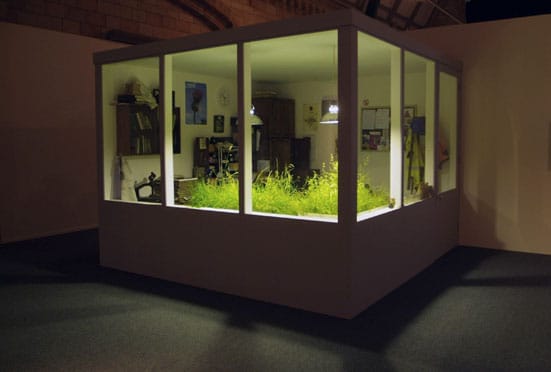15th June 2007 — 2nd September 2007
This
commission commemorates the 300th anniversary of the birth of Carl
Linnaeus, a Swedish botanist whose principle legacy to science is a
system that divides living things into groups based on their physical
characteristics. Linnaeus later created a straightforward method for
the naming of species, still in use today, that reduced cumbersome
monikers to simple two-part classifications, known as binomials.
Being a sucker for archaic museums I was overjoyed to
find myself walking into a dimly lit room with a distinct
old-fashionedness about it. In a series of mahogany display cases Mark
Dion has arranged objects liberated from the museum's storerooms. To
titillate naughty schoolchildren, one contains an opened volume with
pressed specimens of tobacco and cannabis leaves mounted on thick
pages. Another shows copies of Linnaeus' books, including 'Systema
Naturae', from which the exhibition's title is derived.
The detailed handbook provided on entry explains that the items in the
third case date from Victorian times, reflecting the enthusiasm for
nature study that the likes of Linnaeus, and later, Darwin, had given
rise to: how-to-do-it booklets, microscope slides, shell collections,
magnifiers, secateurs, vented boxes for keeping insects alive in and
packets of pins for skewering them on. The wall behind the cases is
papered with browned botanical engravings and hung with portraits of
the botanist, butterfly nets and spades and, on a plinth, a
Persil-white bust of the man in Roman garb, smiling benevolently from
the middle of a colourful animal-vegetable-mineral still-life
arrangement.
On the other side of the wall sit Dion's four fieldwork
projects, which he undertook with a team of experts and helpers. The
first was at the future Olympic site. There is a room, with large
windows, a simulacrum of an office with rectangular boxes of wild grass
and weeds. This, we are told, is invasive vegetation. A TV screen shows
Mr Dion holding a lump of sod aloft, scrutinising it thoughtfully like
a large hotdog. A museum chap is seen pressing plants and mounting them
in a room, much in the way that Linnaeus must have done. Creepy
crawlies found in the earth are discussed, along with plenty of
statistics. I press my nose against the glass to see more, but many of
the details of the room are tantalisingly out of reach.
Next. One of those electric cars with a sticky tape covered
screen on the roof. We can see the journey in the TV screen in the back
window of the vehicle. This fits with Linnaeus' ecological leanings. Mr
Dion is in the passenger seat with a butterfly net. Even at 40 mph,
most of the insects are crushed to oblivion. DNA testing to the rescue.
Flies, beetles, aphids and wasps, we learn. Another room, all white
this time, like a portacabin. On the whiteboard is a description of the
journey in cod victorianspeak.
On the walls, giant photos of the invertebrates, intact
versions. On the table, technical equipment, more stuff we can't quite
make out and on the glass sliding door something scientific, but it's
backwards so we don't know what it says.
A tannoy blares: "Saffron, please make your way to the main hall by the
large dinosaur where Vanessa is waiting for you" Next. Material that
has been collected from the Thames is arranged in a polytunnel. A
mountain of dirty polystyrene, a pile of tatty footballs, jars of eely
looking things, and a rather sweet collection of identical yellow
plastic ducks, and dozens of plastic bottles, all classified, within,
again, the trappings of a laboratory. This time the obscured view
doesn't grate. The detritus is beautifully softened through the thick
plastic. The film shows collecting and scrubbing of the objects. Fish
and a rare seahorse are found and returned to the river.
The film shows a lot of talking though, and as I can't lip-read I feel
I'm missing something.
The last lab is not enclosed. A wooden balustrade keeps us at
bay. The desk is piled , again, with equipment and books. A stand-up
blackboard but it's perpendicular to us so we can't read what's on it.
Earth, air and water have been dealt with. Now it's the turn of homo
sapiens. Dion has taken his team to three Victorian cemeteries which
could yield many fine personalities to knit the elements together. At
East Finchley samples are taken from evolutionary theorist Thomas Henry
Huxley's grave, which fits, though the connection is left hanging. On
the monitor Dion affects a Sherlockian pose with his magnifying glass.
He's also plumped for Emmeline Pankhurst and Karl Marx and it takes an
age for the penny to drop. The rise of women and revolutionary social
architecture in society? Marx in particular seems rather
over-optimistic. Dion is clutching at straws. He's spread his project
too thinly. There's less to it than meets the eye, drowning in piles of
his artfully positioned paperwork. Something's missing, and I'm
starting to fantasy-complete the job myself.
What about Francis T.Buckland? Natural historian.
Anti-evolutionist. Scourge of Darwin. Author of 'Effects of valerian on
skunks' A Daily Mail firebrand of his time. Or Faraday, father of
electricity and benzene, and all the ecological paradoxes they've
resulted in. Subterranean myself, homebound on another relic of
Victorian industry, surrounded by discarded freepapers, a photocopy of
Highgate's funerary celebs on my lap, I suddenly alight upon it. The
everyman for our paranoid 21st century worldview. Adam Smith, criminal
mastermind, genius of disguise, and, here's the clincher: inspiration
for Conan Doyle's Professor Moriarty.
PH
Natural History Museum
Cromwell Road
London SW7 5BD
http://www.nhm.ac.uk/
Open
Daily, 10am-5.50pm

Systema Metropolis Fieldwork 2
A Recreated Lab with Turf Samples from the Olympic Park Development Site
C Mark Dion and Natural History Museum